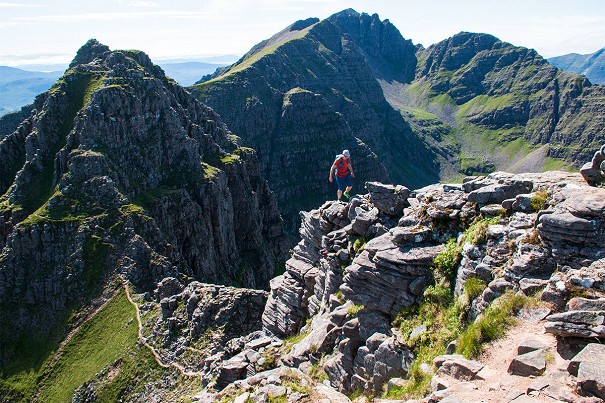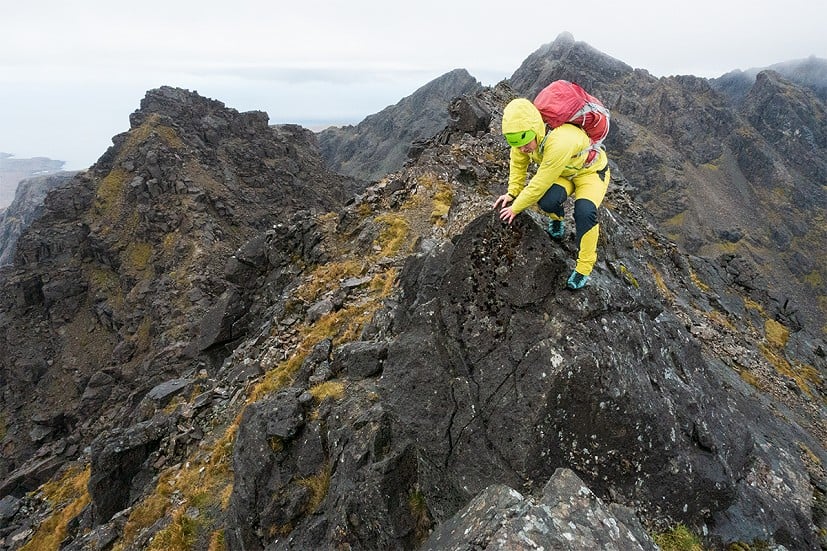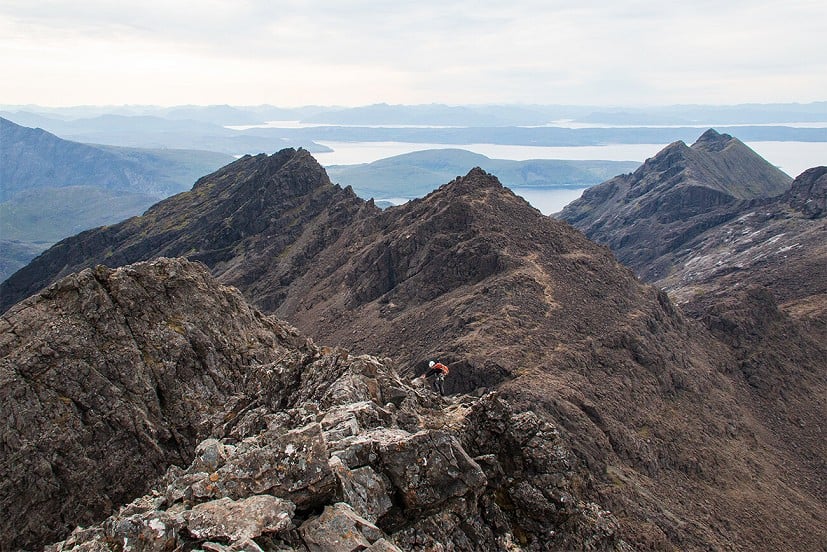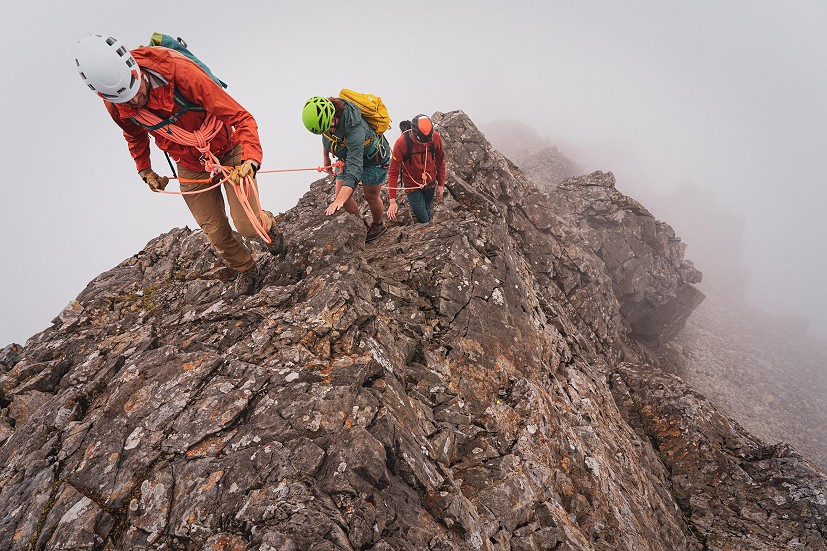
Scrambling Classic Scramble - Liathach Traverse, Plus a Bit
How do you improve one of the great ridge traverses of Scotland? With a bonus extra hands-on start, says Dan Bailey.
Having helped dozens of Munroists of all abilities complete their Cuillin Munros and Tops, guide Tom Lawfield outlines key considerations for would be peak-baggers keen to take on the UK's most challenging mountains.
For the hillwalking Munroist, the peaks of the Cuillin Ridge have a formidable reputation, requiring both difficult route finding and technical scrambling on often highly exposed and serious ground. Of the current list of 282 Munros, 12 are on Skye, with 11 of those on the main Cuillin Ridge itself. Add a further nine Munro 'Tops' (satellite peaks), of which eight are on the Cuillin Ridge, and it's clear that Skye presents a major mountaineering hurdle in the path of every non-climbing hillwalker hoping to complete their Munros.
Aged around 20, I made my first trip to the Cuillin with a friend. After getting rained off a traverse, we descended back to the Glen Brittle campsite. After my mate left for home, I stayed on for another week, gradually picking off the individual Munros. I don't remember having a guidebook, but I do clearly recollect being clueless, and some wandering around in the mist.
Naïve, inexperienced and cold, I was repelled by a dripping In Pinn – in my diary I recorded: 'scared out of my wits by the exposure, the presence of two ravens that appear below me as I climb – and the wet, polished rock.' I turned back at the half height belay ledge, my tail between my legs.

As usual in the hills, with a bit of thought and careful route selection, the problem can be broken down into digestible chunks. Here's how:
There are two broad approaches to climbing the Skye Munros:
1. As part of a Cuillin Ridge Traverse, including climbing the Munros on the way (then later mopping up any that were not summited during the traverse, such as Sgùrr Dubh Mòr). The full traverse is already a significant mountaineering undertaking, only made harder by adding on all the Munros. However it's possible to take a 'scrambling' line that avoids at least some of the harder climbing pitches, if not all of the abseils:
2. If the primary goal is the Munros (especially if including the Tops, or the weather is against you), for most people a far more reliable strategy is conducting more manageable day outings - you can bag the lot over four or so logical and manageable days.
Which approach is most appropriate to you depends on your scrambling skill, aspirations and fitness – and, as ever, the weather. This article focuses on the second option above, as it will be most suitable for the majority of Munroists.

Route finding without getting lost
Compared to the relatively benign Mainland hills, the Cuillin has significantly more complex, steep and featured terrain. Paths are sometimes non-existent, but where they do exist they often form a myriad of misleading sub paths (for example in Coir' a' Ghrunnda). While the ridge is extremely exposed in places it is not always a single narrow crest, but can present a confusing array of slabs, walls, ledges and pinnacles. This demands both traditional navigation skills on the approach and descent, and also the dark art of scrambling/climbing route finding once on the ridge proper – especially taxing when visibility is poor. It is possibly helpful to think of the Cuillin as more Alpine in stature, where the accurate use of guidebook descriptions and timings become critical.
Tools of the trade
A compass is of sometimes limited value due to the iron deposits in the gabbro geology skewing the needle.
By far the best map is the Harvey The Cuillin (2014), which includes both 1:25,000 , and 1:12,500 scale mapping. The use of the 15m contour interval and the uncluttered crag representation seem to lend themselves well to the complex topography of the Cuillin. Having a GPS or app is invaluable too, for confirmation of exact position.
Technical scrambling
While many of the difficulties posed by a full ridge traverse can be avoided by the Munroist doing day hits, there are significant sections of Grade 1, 2, & 3 scrambling, while the Inaccessible Pinnacle is a 65m multi-pitch rock climb of Moderate grade, with a stomach-churning sense of exposure and a committing vertical abseil descent.
Some scrambling is necessary for classic mainland Munros such as the Aonach Eagach, but the Cuillin places more significant demands on the scrambler due to both its difficulty and its sustained nature, which takes a physical but also a mental toll. A delicate approach is required with the loose rock that abounds, even on the trade routes.
Weather
'The Misty Isle' may in fact not get significantly higher total rainfall than on the west coast of the Mainland but the rapid surface run off on the bare rock can quickly soak the scrambler to the skin. On the other hand, the quick runoff also means it tends to dry quickly, even with a light breeze. The fine grained basaltic rock is especially treacherous when wet, while the coarse grained, grippy gabbro still requires care. A combination of MWIS, and the peak specific Met Office Mountain Forecasts (Gillean, Ghreadaidh and Alasdair are included) seems to work well.
Always feels a long day, including the highest peak on the island, but it's a superb trip
9-12 hours

Sgurr nan Eag (Grade 2) can be reached via a steep pull up boulder fields from Loch Coir' a' Ghrunnda. Bags are sometimes stashed before an out and back. Intricate route finding follows down to the Caisteal, before ramps lead up to Sgùrr Dubh an Da Bheinn.
Sgurr Dubh Mor (Grade 2) Often done as an out and back from Sgùrr Dubh an Da Bheinn, the excellent ridge descent and final steep system of ledges can take around 1 hour round trip.
Sgùrr Alasdair (Grade 3) A chimney and broad gully access the summit of the highest peak on the island (992m), before obvious scrambling (Grade 2) drops down to the top of the infamous Great Stone Shoot. The Great Stone Shoot is best descended with helmets still on - rock fall is a very real risk here, made slightly safer by following a parallel gully at half height until forced back into the firing line.
Highlights include:
Adding in the Tops:
Sgurr Dubh an Da Bheinn is ascended to access Sgùrr Dubh Mor, so combines very well on this day.
Sgurr Alasdair - Sgurr Sgumain requires an 'out and back' detour (Grade 2, 30-40 extra minutes from the SW flank route up Sgùrr Alasdair).
Sgurr Thearlaich requires a second 'out and back' (Grade 3, 30 mins).
Generally the In Pinn is done on the best weather day.
8-9 hours
Sgurr Mhic Choinnich (Grade 2). From Coire Lagan hugging the cliffs to the south of Sgùrr Dearg is far more efficient than taking the screes direct, and quickly accesses the ridge. Sgùrr MhicChoinnich gives straightforward but sustained Grade 2 scrambling to the summit.
Sgurr Dearg (Inaccessible Pinnacle) (65m, Grade Moderate, 17m abseil). Holding something of a fearsome reputation, the In Pinn is a graded rock climb of Moderate standard via the East Ridge – arrive early to avoid the queues, either via the committing An Stac (Grade 3), or the stonefall-prone screes bypass (Grade 2). Two pitches of exposed moves followed by a steep abseil make this peak a challenge for any Munroist unfamiliar with rock climbing. Most will opt to touch, rather than climb onto the 'Bolster Stone' – which sits atop the Pinn.
Sgurr na Banachdich (Grade 2). After the In Pinn, the tops of Banachdich provide delightful scrambling before a descent of Coire a Eich.
Highlights include:
Adding in the Tops:
Sgùrr na Banachdich Central Top is easily included by taking the excellent ridge (Grade 2, 15 extra minutes to take ridge rather than Banachdaich South Ridge bypass).
Sgurr Thormaid (Grade 2, can take up to an hour on tired legs) may be done as an 'out and back' from Banachdaich.
Generally this shorter route is done on the worst weather day, as not only is the volume of challenging terrain less, but the approach and walk off are relatively protected from SW winds until climbing out of An Dorus.
6-8 hours
Sgurr a' Ghreadaidh (Grade 3). From the top of An Dorus a Moderate move gains access to easier scrambling above along the ridge.
Sgurr a' Mhadaidh (Grade 2/3). This is the quicker and easier of the two peaks – with further time saved by taking a more direct line back into An Dorus in descent.
Highlights include:
Adding in the Tops:
Sgùrr a' Ghreadaidh South Top (Grade 3) can be included as an excellent exposed out and back ridge scramble from Sgùrr a Ghreadaidh itself (allow 35-45 minutes extra).
These are generally done as 'out and backs' from Bealach a' Bastier (bags are sometimes left here - beware raven thefts), before traversing under Am Bastier to Bruach na Frithe.
8-10 hours
Sgurr nan Gillean (Grade 3). The ascent of Tooth Groove (Moderate) gains the Pinnacles – on the way up notice the abseil tat in place that you will use in descent.
Am Basteir (Grade 3). Straightforward other than the Bad Step which deserves its grade of Diff, especially in the wet (don't be too proud to abseil it if required) – or avoid the Bad Step via complex ledges on the Lota Coire side.
Bruach na Frithe (walk). After returning to the bags, descend beneath the imposing cliffs of Am Bateir's North face, before walking on paths over to the summit.
Highlights include:
Adding in the Tops:
Basteir Tooth: Jutting prominently from the side of its parent peak, this dramatic feature is reached via a short abseil from near the summit of Am Bàsteir. Pad up to the tip in a superb position, then retrace your steps, and make a further abseil down Kings Cave Chimney (20m). Allow 30-45 mins total. The same point can be reached via the great (but loose) Lota Coire route (Grade 2), although from there it's either retrace your steps or Severe 4a moves up a steep wall to reach the summit of Am Bàsteir itself.
Bruach na Frithe - Sgurr na Fionn Choire (2/3). Easily included in an extra 15-20 mins.
Note the Knight's Peak on Gillean has been demoted from Top status, but is still excellent and well worth doing via Pinnacle Ridge, a big mountaineering day out in its own right.
Bigger combination
For ambitious Munroists who wish to climb the Tops, (and if weather and fitness allow), combining day two and three into one very long day makes a good alternative option (11-13 hours).
Standing apart form the main Cuillin ridge, the stunning Munro Bla Bheinn is a straightforward walk, and those wishing to do the South Top generally find the short exposed grade 1 ledge on the NE side between the two peaks to be airy, but obvious. The two Corbetts and five Grahams on Skye are all non technical.
Guidebooks such as Cicerones excellent The Cuillin Ridge Traverse have made the Cuillin Ridge accessible to a wider audience, including Munro baggers. This goes a considerable way to addressing the Munroist's route finding challenges in the Cuillin. However, it does not give one the skills to safely negotiate the technical scrambling terrain of the Cuillin, which is often serious. For those that aspire to climb the Cuillin Munros, three options present themselves:
Unguided
This would normally be done with a capable mountaineering partner, and may involve the use of a rope to safeguard key spots such as abseiling Tooth Chimney on Gillean, descending the Bad Step on Am Bàsteir, or down into An Dorus. The Inaccessible Pinnacle is definitely a step up – perhaps requiring learning rock climbing skills through attending formal training or getting the assistance of a competent rock climbing friend. Given the need for judgement regarding the suspect rock, the exposed position, and the busy queues, this is unlikely to make a good first multi pitch lead.

Hire a guide
Numerous excellent guides operate on the Cuillin and many offer Munro-bagging specific courses at various price points. This is widely considered the most straightforward and safest way of doing the Cuillin Munros, as the guide will carefully tailor the course to your needs and the weather. They should be both qualified and insured – and many will also be members of the Association of Mountaineering Instructors (AMI), or British Mountain Guides (BMG).
A combination of guided and unguided
Perhaps do the 'easy' Cuillin peaks (Bruach na Frithe, Banachdaich, Blà Bheinn) individually to get a feel for the ridge, then the harder peaks with a mountaineering friend or guide.
While most Munro fans are used to long days, some are surprised at the extra physical demands of the Cuillin. Long passages of scrambling on rough rocky ground are more akin to an Alpine trip than a hillwalk as many may know the term, and non-climbers are likely to feel it after a big Skye day. Having a day off built in works well for recovery – perhaps most sensibly taken in the worst weather of your trip.
Normal Munro walking kit is perfectly adequate for the Cuillin, with some additions:
Scrambling boots - ideally a more technically-capable boot than your standard walking footwear, since these offer more foot support and will include a climbing-specific toe area on the sole (eg. La Sportiva Trango, Scarpa Ribelle). Even modern boots benefit from a day or two of breaking in, despite what the manufacturers say.
Approach shoes - when the weather is dry, an approach shoe is lighter and more nimble, so definitely preferable. There is no need to have a waterproof lining as they are only used when rain is unlikely (eg. La Sportiva Boulder X, La Sportiva TX4, Scarpa Mescalito, Unparallel Rock Guide).
Gloves – leather survives best against the sharp gabbro rock. Gardening/work gloves make a far cheaper and normally equally hardwearing alternative to posh mountian handwear, but make sure they fit with enough dexterity to handle carabiners/rope, even when wet. Waterproof leather mountaineering gloves can be useful on the wettest days, particularly early and late season when it can still be cold.
Technical gear – harness, helmet, 40m rope, belay plate and small trad rack.
The additional challenges of the Cuillin suggest a more in-depth and rigorous reading of guidebooks is required than many other Munros. The following are all recommended.
Skye The Cuillin, Mike Lates (Scottish Mountaineering Club)
Skye's Cuillin Ridge Traverse, Adrian Trendall (Cicerone)
The Cuillin & Other Skye Mountains, Tom Prentice (Mica)
Scotland's Mountain Ridges, Dan Bailey (Cicerone)
Background Reading
The Black Ridge: Amongst the Cuillin of Skye, Simon Ingram (William Collins)
Perfect background reading for any trip to Skye, and particularly for those heading into its hills. Part personal narrative, part history of the early pioneers, this homage to this wild land of basalt and gabbro is sure to inspire and delight.
Tom Lawfield guides private Cuillin Munro courses each Spring/Summer through Summit Guides. With two decades of Munroing experience and as a 'compleater' himself (No. 4084), Tom and his team are well placed to help you climb your Skye Munros. Summit Guides courses are known for small group sizes (typically 1:1 or 1:2), a personalised approach focused on your needs, and friendly and experienced instructors. Get in touch via info@summitguides.com

Comments
Great write up Tom. Thanks again for picking us up as we were thumbing a lift at the fairy pools and dropping us off at the Slig campsite in May. Going back in Sept for another go, all the best with the rest of your season!
A pleasure to meet you, how did your trip go this time?
Sadly we didn't even travel up, the weather wasn't good for the time off we booked. Back next May. All the best!